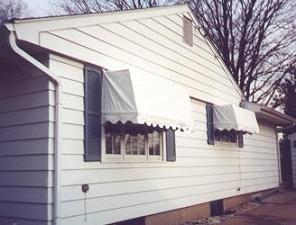Add style and beauty to your home and save energy costs at the same time.
The most common and least expensive awning for your home is called a "Loose Frame" awning. A loose frame awning has a "U" shaped lower metal frame that is attached to the house using what is called a hinge. This hinge allows the lower frame to move up and down. This is why this type of awning is called a Loose Frame awning since it will move up and down.
Welded Frame Awnings are also available for residential use. However, since welded frame awnings cost more they are are more commonly used for commercial applications.
Visit our Photo Album for more examples of awnings.

Why add Awnings to your home?
Awnings will improve the look of your home by giving it color, depth and style. There are around 200 solid and stripe awning patterns to choose from.
Before

After

Awnings will help to keep your home cooler by stopping the sun's heat outside. Yes, drapes and shades will stop the sun's heat. However, they stop the sun's heat inside your house house. Plus with your drapes closed you cannot see outside and the inside of your house is darker so you have to turn on lights which cost you money.
Studies have shown that awnings will lower the temperature inside a house by 7° to 15° F over the same house without awnings. If you need to run your air conditioning it will not have to work as hard, and therefore saving you money on energy costs.
Awnings will save you money by protecting your expensive hardwood floors, carpets, furniture and drapes from fading from the sun's harmful ultraviolet rays.
Awnings will help to keep the rain out of opened windows. And if the rain stays off your windows you may not have to wash your windows as often.
Three Common Loose Frame Awning Styles
#1 - "Traditional" Single-pitch Loose Frame Awning

This is the most common awning style. It is used on double-hung windows that sliding up and down to open, windows that slide side-to-side to open, windows that tilt out hinged at the top or for windows that do not open.
#2 - "French" Double-pitch Loose Frame Awning

This style awning is used with casement crank-out windows when extra room is available above the window. The top of the awning is usually attached to the house 6" or more above the window. A second upper frame is used to allow the window to open without rubbing on the under-side of the fabric.
#3 - "Box" Double-pitch Loose Frame Awning

This style is used with casement crank-out windows when no extra room above the window is available and a French style awning cannot be used. Like a French awning, the second upper frame is used to allow the window to open without rubbing on the under-side of the fabric.
Installation Instructions for Loose Frame Awnings

Ropes may be added to raise and lower the awning to allow more or less shade as needed. Pulling up an awning will allow more light inside the house if needed. Box and French style awnings cannot usually be roped.
I do not recommend leaving an awning pulled up for extended periods like all winter. Rain, snow or ice may collect in the pulled-up awning causing water stains, mildew and other damage. Also birds and squirrels have been known to build nests inside pulled-up awnings causing permanent damage.
I have found that most customers no longer want the ropes installed.
